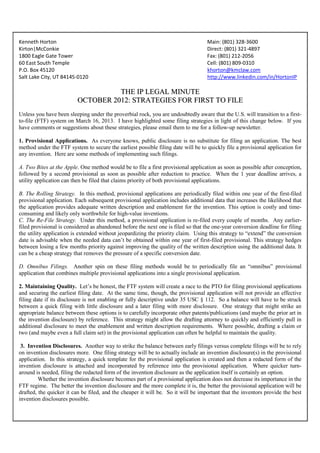
October 2012 IP Legal Minute
- 1. Kenneth Horton Main: (801) 328-3600 Kirton|McConkie Direct: (801) 321-4897 1800 Eagle Gate Tower Fax: (801) 212-2056 60 East South Temple Cell: (801) 809-0310 P.O. Box 45120 khorton@kmclaw.com Salt Lake City, UT 84145-0120 http://www.linkedin.com/in/HortonIP THE IP LEGAL MINUTE OCTOBER 2012: STRATEGIES FOR FIRST TO FILE Unless you have been sleeping under the proverbial rock, you are undoubtedly aware that the U.S. will transition to a first- to-file (FTF) system on March 16, 2013. I have highlighted some filing strategies in light of this change below. If you have comments or suggestions about these strategies, please email them to me for a follow-up newsletter. 1. Provisional Applications. As everyone knows, public disclosure is no substitute for filing an application. The best method under the FTF system to secure the earliest possible filing date will be to quickly file a provisional application for any invention. Here are some methods of implementing such filings. A. Two Bites at the Apple. One method would be to file a first provisional application as soon as possible after conception, followed by a second provisional as soon as possible after reduction to practice. When the 1 year deadline arrives, a utility application can then be filed that claims priority of both provisional applications. B. The Rolling Strategy. In this method, provisional applications are periodically filed within one year of the first-filed provisional application. Each subsequent provisional application includes additional data that increases the likelihood that the application provides adequate written description and enablement for the invention. This option is costly and time- consuming and likely only worthwhile for high-value inventions. C. The Re-File Strategy. Under this method, a provisional application is re-filed every couple of months. Any earlier- filed provisional is considered as abandoned before the next one is filed so that the one-year conversion deadline for filing the utility application is extended without jeopardizing the priority claim. Using this strategy to “extend” the conversion date is advisable when the needed data can’t be obtained within one year of first-filed provisional. This strategy hedges between losing a few months priority against improving the quality of the written description using the additional data. It can be a cheap strategy that removes the pressure of a specific conversion date. D. Omnibus Filings. Another spin on these filing methods would be to periodically file an “omnibus” provisional application that combines multiple provisional applications into a single provisional application. 2. Maintaining Quality. Let’s be honest, the FTF system will create a race to the PTO for filing provisional applications and securing the earliest filing date. At the same time, though, the provisional application will not provide an effective filing date if its disclosure is not enabling or fully descriptive under 35 USC § 112. So a balance will have to be struck between a quick filing with little disclosure and a later filing with more disclosure. One strategy that might strike an appropriate balance between these options is to carefully incorporate other patents/publications (and maybe the prior art in the invention disclosure) by reference. This strategy might allow the drafting attorney to quickly and efficiently pull in additional disclosure to meet the enablement and written description requirements. Where possible, drafting a claim or two (and maybe even a full claim set) in the provisional application can often be helpful to maintain the quality. 3. Invention Disclosures. Another way to strike the balance between early filings versus complete filings will be to rely on invention disclosures more. One filing strategy will be to actually include an invention disclosure(s) in the provisional application. In this strategy, a quick template for the provisional application is created and then a redacted form of the invention disclosure is attached and incorporated by reference into the provisional application. Where quicker turn- around is needed, filing the redacted form of the invention disclosure as the application itself is certainly an option. Whether the invention disclosure becomes part of a provisional application does not decrease its importance in the FTF regime. The better the invention disclosure and the more complete it is, the better the provisional application will be drafted, the quicker it can be filed, and the cheaper it will be. So it will be important that the inventors provide the best invention disclosures possible.